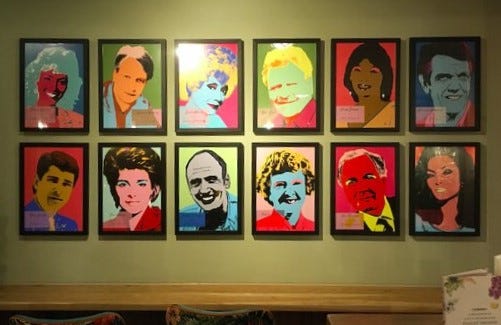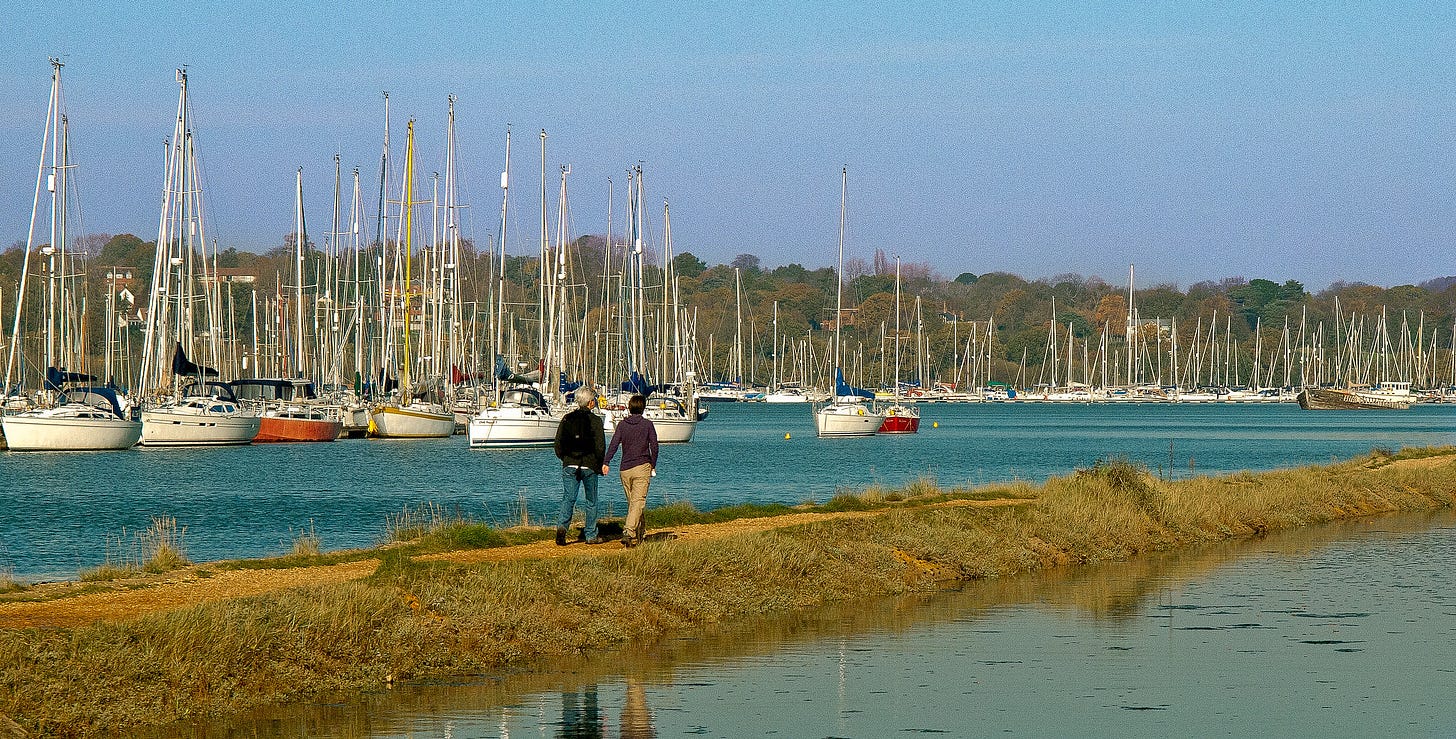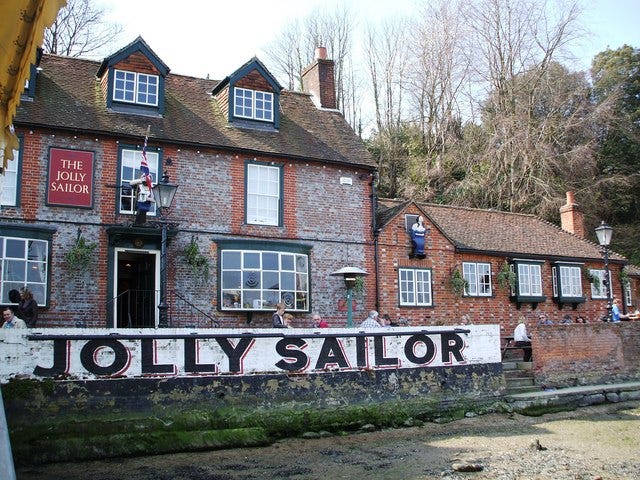It’s a Sunday in mid-July and I’m standing at the bar of The Jolly Sailor, a favourite watering hole among residents of the River Hamble on the south coast of England where I grew up. It is every inch a traditional English pub, save for a wall beside the bar filled with pop art prints. The faces in the frames are not Warhol’s celebrities. They belong to the cast of Howards’ Way.
If you don’t remember it, Howards’ Way was one of Britain’s biggest soap operas of the peak Thatcher years. Every Sunday between 1985 and 1990, millions tuned in to follow the travails of the industrious Howard family in the fictional yachting town of Tarrant. The show’s theme song, ‘Always There’, entered the UK singles chart at number 13.
The real Tarrant meanwhile was always here, in Bursledon, where the river fans out beneath the terrace of the Jolly Sailor. The show turned its shores into a glistening dreamscape of eighties glamour. It turned the Jolly Sailor into a tourist attraction for diehard fans around the world. And, if you lived here while it was being filmed on your doorstep, it mirrored your own ascent on the tide of middle-class aspiration. Here on the Hamble is where Thatcher’s vision was immortalised, and where residents never stopped believing in it.
Howards’ Way was an orgy of haute couture, fast boats, big houses and saxy romance. Conceived by TV producer Gerard Glaister as the BBC’s answer to Dallas, it gave Brits their version of the Ewings – a family on which to pin their fears, hopes and dreams in a turbulent decade. The show took a different point of view to many hit dramas set in the same period. While Boys from the Blackstuff was a commentary on the North, Howards’ Way was about the South. While the former critiqued the economy, Howards’ Way championed the entrepreneurial spirit.
The story starts with a divorce. Tom Howard is an aircraft designer and draughtsman who resolves to be his own boss after taking a golden handshake from his employer of more than 20 years. This triggers the breakdown of his marriage to Jan Howard, rocking the Howard children, Leo and Lynne, and forcing Tom and Jan to seek mutual financial independence.
As the family core dissolves, each of the four Howards must find their own way and learn to embrace change.
At the Mermaid Yard where Tom eventually applies his skills to modern boat design, boat-builder Jack Rolfe struggles to keep his daughter Avril’s loyalty to the family’s failing business. Forever seeking refuge in The Jolly Sailor, Rolfe openly laments the decline of manual skill, the disappearance of wood from boat structures, and the loss of respect for honest work where money itself makes money. Yet, Avril Rolfe is too bright and too young not to see which way the wind is blowing. She convinces Jack to let Tom save the Mermaid Yard and later blazes her own trail as a high-powered investment advisor to ruthless property magnate Charles Frere.
Determined to throw off the shackles of a homemaker, Jan launches her own retail fashion outlet dubbed ‘The House of Howard’. She is quickly pursued by Ken Masters, a working-class underdog hell-bent on conquering both Jan and the South’s commercial yachting market. While Lynne eventually moves to the Mediterranean to teach sailing, Leo pours his grief for the family into an environmentalist crusade to halt the construction of luxury complexes along Tarrant’s wild shores.
Behind all the hammy one-liners, bedazzled outfits, engine-rev and sea-spray, Howards’ Way is the story of a country moulding to Thatcher’s radical libertarianism.
The show is unapologetically pro-Thatcher too, dividing its characters as Thatcher herself divided Britain, into go-getters and ‘don’t-getters’. The go-getters of Howards’ Way seize upon the age of individualism, technology and commerce, trusting little beyond themselves and the wisdom of markets. They are quick to cultivate or cut ties where expedient and make up for the subsequent loss of social capital with material wealth. The don’t-getters, meanwhile, just don’t get it. Though characters like Jack Rolfe and Leo Howard despise the moneymen carving up Tarrant, they are portrayed as sleepy creatures of habit rather than reactionaries. They represent the small-thinking, anti-growth localists Thatcher derided, and that the show subliminally places on the losing end of the argument.
The Howards are the show’s most complex characters, which is to say they are the most conflicted in this brave new world. You root for them as a family, even as they increasingly atomise into agents of rational self-interest. Their struggle to fully assimilate this attitude keeps them a family throughout all six seasons, lending contrast to more darkly avaricious characters, such as Frere or Masters. Yet, the Howards are always influenced by forces bigger than themselves, both individually and as a unit. In Howards’ Way, every character ultimately seeks to increase their lot, and so the plot feeds off pitting interest against interest in a quagmire of sexual politics, class prejudice, reputational risk and financial exposure. By the end of the show, the Howards are completely transformed, just like the country that followed them from the start.
I was born at the peak of the show’s popularity in 1988 and moved with my parents to the Hamble just as the show entered its final season. I was too young to remember it then, and it took me another 30 years to know it even existed. Bingeing Howards’ Way in the spring lockdown of 2020 was a surreal homecoming. Once I’d gotten past the spectacle of it, however, I viewed Howards’ Way less as fiction and more as a true reflection of what was happening to this corner of the country at an historic economic and cultural watershed. Though the film crew may have packed up and left for good in 1990, the show went on, and the place I called home for 20 years was, and remains, very much Tarrant.
Spend time in Howards’ Way country by the River Hamble now, and you will see many of the show’s themes still in play. Faceless real estate developers cordon off ever-dwindling pockets of litter-strewn countryside, and NIMBYist groups respond by taking legal action to stop the diggers. Newbuilds are readily snapped up by retirees, whose time is split between managing and expanding their portfolios.
Divorce and separation are common in this part of the country. According to the latest Census from the Office of National Statistics, Portsmouth and Gosport have some of the highest divorce rates in the UK, with Southampton not far behind. Beyond weddings and funerals, churches struggle for attendance – respondents to the same Census overwhelmingly report having ‘no religion’. The business of soulcraft in Howards’ Way country is, in practice, just that: running your own limited company, becoming self-made.
I’ve seen the local bakers and butchers vanish from my village high street only to be replaced by two cosmetic surgery clinics. This slouch towards California feels all the more palpable given that the people of Howards’ Way country drive absolutely everywhere. They took Thatcher at her word when she said that a man who finds himself on a bus beyond the age of 26 could count himself a failure. And, with an average of two cars per driveway, they’ve never had time for net zero.
Thatcherism is preserved here by people who keep dancing to its tune though they stopped hearing the music long ago. But as the UK nears the next general election, I get the feeling Rishi Sunak and Keir Starmer are already serenading these constituencies. Early messaging from both candidates has a distinctly throwback feel redolent of the Howards’ Way era.
Last year, Southampton’s own Sunak vowed to run the economy like Thatcher. In July this year, he sat gleefully behind the wheel of Thatcher’s old Rover “talking about freedom” and mocking “anti-motorist Labour”. Keir Starmer put his hand in the fire four months earlier when he said Thatcher had been right to call the rule of law the “first duty of government”. Starmer may have faced greater backlash for this heresy, but it’s clear both candidates are overreaching to scratch a nostalgic itch that can make the floating voter in the South believe a return to growth is possible on their watch.
I duck out of the Jolly Sailor to find a group of 20 people waiting to be taken on the Howards’ Way walking tour – the third of the season. All are local, of an average age of 60 and have seen Howards’ Way back-to-back at least four times. I join them and immediately stand out as the youngest of the group. The tour guide is an elderly lady from Leeds accompanied by her husband. She explains how they moved down to the coast in 1985 and came up in the world as Howards’ Way hit the airwaves. Throughout the tour, walkers speak of “Jan” and “Jack” and “Tom” as if remembering deceased members of the community.
I ask why they’ve come. “We’re local,” a couple answer bluntly. Others tell me they started re-watching the show when the first season was rebooted on UKTV Play at the start of the year. “It all reminds me of my youth,” one Asian-British lady in her mid-fifties tells me. “Things felt safer back then. I was young, just having fun. I felt like I could do anything.”
She gestures behind her to a friend who she describes as a “superfan” of the show. The woman who strides towards us to claim the title is in her sixties. “It was a wonderful time back when Howards’ Way was on telly,” she says. “I loved the fashion. I loved the music. I even owned a Ford Escort XR3i. That was a nice car to have then.”
We pause at the gates of a mansion situated at the end of a long, winding stone driveway. Everyone instantly recognises it as the home of the Howard family. “Deary me, I’ve got property envy!” one of the walkers blurts out. The house we’ve just passed also features in the show and is now on the market for £1.9 million, according to our guide. “It’s back to my three-bedroom after this!” another exclaims.
As we make our way back towards the Jolly Sailor, I get talking again to the woman with the ex-Ford Escort. She nods when I suggest that Howards’ Way is a uniquely intoxicating show for people who spent the prime of their lives here while it was being made. Does it affect how she sees Thatcher’s legacy?
“I suppose there was the haves and have nots then too, but it’s different now,” she says. “A minority have the majority of everything. I never had grand ideas about getting rich or anything like that. I just remember doing quite well in those years.”
The tour ends. The group slowly disperses. Some stay for drinks at The Jolly Sailor. From the terrace I look left out towards the Mermaid Yard, then right towards Ken Masters’ old office on the slipway off Bursledon Bridge. I wonder how viewers must have felt on the morning of the Monday after the show’s finale, less than a week after Thatcher tearfully waved goodbye to Number 10.
Not everyone who moved here in the eighties launched a fashion empire, bought a sunseeker or graduated to the scale of living embodied in the Howards’ family home. Nevertheless, the River Hamble remains the home of the haves and have yachts, a daily reminder that most of the winners of the Thatcher period were people who dreamt big, did well, yet were left wanting more.
This England, my England, is where Thatcher’s dream was romanticised on primetime and realised in real time, and where it now lies dormant, waiting for a prime minister who will step up, dust it down, and play it one more time.







